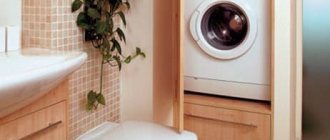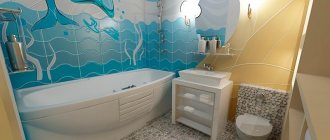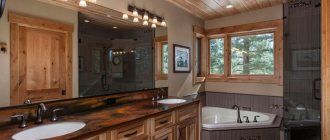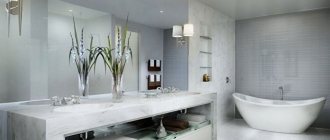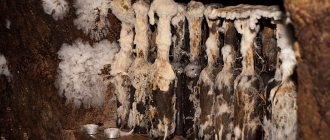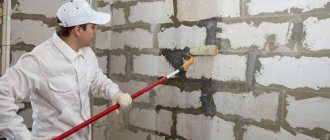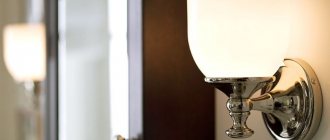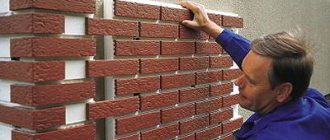How do mold spores appear?
Mold has lived on earth for millions of years, its mycelia are found wherever there is dampness, little sunlight and no air movement. Tiny fungal spores are in the air, and they can settle anywhere, as long as favorable conditions are created for them. Humidity is more than 90%, air temperature is above +20 degrees and mycelium colonies begin to grow at lightning speed. You can notice the appearance of mold in the dark corners of the garden, in the cellar, basement; it happily settles in the kitchen near the sink, in cellophane-packed products.
The bathroom is the perfect place for fungus to grow. The humidity level in the bathroom is the highest in the entire apartment. After taking a shower, bath, or hand washing, water droplets dry for a long time, condensation forms on all surfaces, thereby creating easy places for mold mycelium to multiply. Why does mold occur in the bathroom, and what to do to prevent its growth?
Ventilation in the bathroom is the best remedy for mold
Black mold also appears in poorly ventilated areas. In bathrooms, simple conventional ventilation is not enough. A poorly functioning hood in a damp room can also cause fungus.
It has been noticed that in bathrooms that have a window, mold occurs less frequently. The sun's rays penetrating into the room kill mold spores, which are destroyed by UV rays. You may notice that where there is not enough sunlight, namely corners, damp places under the bathtub, behind the sink, black, gray and yellow-green plaque appears.
Reasons for appearance
Mycelium spores are present in every room. But for successful reproduction they need warmth and moisture. The heating system and constant humidity above 90% provoke the development of microorganisms. Tiny black or greenish spots quickly grow into large, unpleasant blots. Other reasons for this scourge include:
- poor ventilation - stagnant warm air is good for the growth of bacteria;
- poor waterproofing of floors, walls and ceilings - coatings that are not properly treated become damp, providing a breeding ground for black plaque.
The fungus multiplies not only on the surface of the walls, but also on furniture, the back wall of the washing machine, and the bottom of the shower tray. Leaks from pipes can provoke its appearance. Water, dripping little by little, constantly moistens the floor, creating a favorable nutrient environment.
Mold and our health
Mold happily settles in our bathroom, under tiles, in tile joints, paint, under plastic, on cement surfaces, causing harm to health day after day. A “harmless” neighborhood turns into a big health problem over time. During breathing, spores easily enter the lungs, are absorbed by the blood and spread to all organs. Over time, you may notice dizziness, loss of strength, breathing problems, in particular asthmatic attacks.
Mold in the bathroom - health problems
Studies have shown that mold can cause cancer. Black mold is especially dangerous for children, the elderly, and weakened people.
Important. You can undergo treatment for a long time, but until the cause of the ailment, namely dampness and mold, is eliminated, there will be no positive result.
Instructions for getting rid of fungus from the bathroom
Removing mold is a rather difficult and lengthy process that takes place in several important stages:
- It is necessary to remove places where moisture originates, such as leaking taps, pipes or toilets. They are repaired and brought to full tightness.
- All plastered or painted surfaces that are moldy are removed by deep cleaning. Although it is difficult, this procedure must be carried out.
- Then it is necessary to thoroughly dry all treated areas with heaters, even those that were not exposed to mold.
- After drying, treat with any special antifungal agent, paying special attention to favorite places where fungus appears.
- The main element for protection against mold is moisture insulation of the room, so when painting, use moisture-resistant paint.
- Pay special attention to bathroom ventilation. The constant presence of fresh air will protect the room from the appearance and proliferation of fungus.
Read here: Installing furniture hinges: step-by-step instructions for correct marking, installation and adjustment of a piece of furniture fittings (80 photos)
How to prevent mold
Mold has appeared on the walls, how to fight it? The best way to combat mold is prevention. Of course, if there is no window in the bathroom through which sunlight can penetrate, it is not always possible to do so, especially when you live in a standard apartment. But preventing high humidity is quite possible.
How to get rid of condensation on a pipe
Condensation on pipes - treated with Merylon
The first thing you need to examine is the cold water pipes and the supply to the toilet.
Important. It is also necessary to check the pipes for excess condensation. If there is condensation (sweating pipe), it is better to wrap it with Merylon, this will greatly improve the situation
Checking pipes for leaks (snotty)
And so, first, we check all pipes and connections for water leaks. Perhaps a microscopic crack has appeared, or a connection through which water is leaking has weakened, and mold may appear here.
When renovating a bathroom, we try to close all pipes and communications whenever possible. From an aesthetic point of view, this is completely justified, but by hiding everything behind the panels under the bathtub, behind the sink, behind the washing machine, we may not notice a water leak during the process.
And only when a puddle appears, dampness is felt, mold becomes noticeable, we begin to do something. It is necessary to check the condition of the pipes and the reliability of the connections from time to time. All plumbing connections must be dry.
We eliminate leaks in pipes
Setting up ventilation
Secondly, it is necessary to establish good ventilation. When repairs are being made, it is worth checking the condition of the stationary hood to see how well it works. It is a good idea to install an additional ventilation system. It could be an electric fan. Longitudinal or circular holes made at the bottom of the bathroom door will improve air circulation. It is also recommended to periodically open the doors for ventilation. This is especially recommended after taking a shower. It is better to dry wet towels on heated towel rails. In summer, when there is no heating, you can install an electric heated towel rail. And, of course, never dry things in the bathroom.
Why does mold appear?
Fungus appears in the bathroom for the following reasons:
- Poor ventilation. Even a constantly closed bathroom door will not cause mold if there is good draft in the exhaust duct.
- Low temperature or changes. When moisture does not dry out, ideal conditions are created for spores to develop.
- Condensation on pipes. Most often found on cast iron.
- Leak. Leaking pipes, faucets or toilets are one of the main causes of mold.
The photo shows what fungus looks like in the bathroom
It also happens that there is no reason for the formation of mold, but it appeared in one single place - perhaps this was due to a leak in the mine. In this case, contact the management company.
Mold prevention
Advice.
To prevent the appearance of mold, it is necessary to select appropriate materials that contain antiseptics during repair work. means against mold and mildew • Antifungal emulsion is added to adhesive and cement mixtures for masonry, plastering, painting walls, and grouting tiles.
The solution is also pre-applied to all surfaces. The emulsion is completely safe. • Izocid prevents the appearance of fungal spores, fights microalgae and other types of fungi. Added to plaster and water-soluble mixtures. • Emulsion “MIL KILL” based on latex, preventing the appearance of fungal flora. Penetrates well into porous surfaces, is non-toxic, can be used in any room with high humidity. • Antiseptic aqueous solution “DALI” is used for prevention and control of existing mold. Can be used in wood processing.
Remedies for mold in the bathroom
Since the problem appeared a long time ago, chemists have found ways to deal with the dangerous phenomenon. In hardware stores you can pick up substances that will remove black deposits forever.
Instagram @vodopad_santehnika
On sale there are both special solutions intended for sanitizing contaminated areas, as well as universal household products for general use.
Special
Bactericidal drugs are powerless in the fight against microorganisms. They act on bacteria, not fungi. Therefore, antifungal and antimicrobial substances are chosen to clean the bathroom. Based on the composition of the base, they are either water-based or oil-based. Some drugs are designed to destroy mycelium, while others are designed to create a film on the surface that prevents its emergence and development.
You need to choose the right product taking into account the base material that will be processed. Since antiseptics contain potent substances, it is important to follow the rules for their application. If it is a concentrate, then you need to dilute it in the specified proportions. When working, ensure your own safety: use rubber gloves, goggles and respirators.
- Based on reviews from buyers of construction stores, we have compiled a rating of the most popular antiseptics: Stop-Mold from the company Olimp (Russia). Can be used for almost any coating. Does not contain chlorine, therefore safe for health.
- Universal antiseptic Dali. Manufacturer: Rogneda company (Russia). An aqueous solution removes all types of mold and mildew on any materials.
- FUNGI CLEAN from the Russian company PROSEPT. Perfectly cleans tiles and grout, plastic, stone, wallpaper and other materials. Fast-acting—the result is noticeable within 10 minutes.
- Anti-mold from the company Quelyd (France). The product contains a synthetic resin, which forms a film on the surface that prevents the growth of mycelium.
- Fongifluid Alpa from Alpa (France-Russia). It is used both for disinfection of premises and for prevention. The drug not only eliminates microorganisms, but also returns the base material to its original appearance.
Instagram @klining_048
Instagram @prosept_belarus
Instagram @interiorclub_krasnoyarsk
Instagram @stroitel2005.ru
Folk
In the absence of factory-made drugs, you can use recipes tested among the people. So, how to clean mold?
- Copper sulfate. Gardeners are well acquainted with this inexpensive and effective substance. Its aqueous solution is sprayed onto the infected area, previously treated with a soap mixture. The surface dries, after which the procedure is repeated as necessary 2-3 times.
- Chlorine. Household substances based on it are effective in combating mycelium. They contain an aggressive component that destroys most fungi. “Domestos”, “Sanita” or “Belizna” not only wash the fabric, but also clean problem areas. The infected area should be washed with a sponge and undiluted solution.
- Vinegar. A 6-9% table solution is an excellent antiseptic. Use a sponge or rag soaked in undiluted vinegar to wipe the problem area and leave until completely dry. Then rinse the surface with water and ventilate the room well.
- Borax. The natural mineral has good antiseptic properties. Use a mixture of 1 cup of borax and 2.5 liters of water to clean the moldy area. After complete drying, remove any protruding crystals with a dry cloth. If the affected area is large, you can spray it with a solution of 1 cup of borax and 4 liters of water.
- Soda. A safe and natural antiseptic is diluted in the proportion of 1 teaspoon per glass of water. This mixture can be used to clean the source of infection using a sponge or sprayer. There is no need to rinse off the baking soda.
- Hydrogen peroxide. An inexpensive and non-toxic liquid that can be found at the pharmacy. When processing colored surfaces, it is possible to bleach the base.
- Ammonia. Well suited for processing dense hard coatings (glass, ceramic tiles). It is diluted in a 1:1 ratio and applied to the wall with a spray bottle or sponge. After a few hours it can be washed off with water. Not suitable for porous materials (wood, concrete, drywall).
Instagram @nataliya_shevlyagina
Copper sulfate is an excellent remedy against fungus. You will have to get rid of contaminated wallpaper or tiles and treat all surfaces
We fight mold in different ways
How to remove mold in the bathroom, what modern and traditional methods can be used? When the first signs of mold appear, you should not waste time and wait until large areas are infected. Let's start the fight right away. Small areas can be treated using everything we have in our kitchen and medicine cabinet.
Vinegar is a tool that can be used to remove small colonies of spores. Acetic acid is safe and disappears quickly. Here's how to remove mold in your bathroom using vinegar:
1. clean the surface with a brush or scraper, if possible; 2. the product is applied to the affected areas of the surface either with a spray or with a swab or cloth;
How to remove mold - instructions
3. after drying, it is necessary to mechanically clean the area; 4. rinse with water; 5. treat with any antiseptic.
How to remove mold - instructions
Hydrogen peroxide is an excellent antibacterial agent. You can use a ready-made solution or dissolve tablets. White effervescent tablets dissolve easily in plain water. Peroxide can be used to clean any surface: plastic, tiles, wooden objects coated with paint, varnish. But we must remember that peroxide also bleaches, which is good for white surfaces, sealants, and grout, but white stains may remain on the furniture. Baking soda and regular bleach, both chlorine and active oxygen, can be excellent means at hand. An excellent remedy for mold in the bathroom is copper sulfate, which is used in gardening work.
Homemade recipes for eliminating fungal plaque in the bathroom
Fungus in the bathroom usually appears first in the corners: on the floor or ceiling. The spores of these microorganisms quickly spread throughout the room, so very little time passes from the first manifestations of the proliferation of pathogenic bacteria to the appearance of extensive spots of black mold on various surfaces.
eliminating fungus in the bathroom
As soon as a small black spot appears on the ceiling, plumbing, pipes or tiles, you must immediately take all measures to combat this unpleasant phenomenon. In the initial stages of mold development, you can do this yourself, using folk remedies that are available to every family, for example, soda and vinegar. Fungal cells are destroyed by these substances, and the growth of the entire colony of microorganisms stops.
It’s very simple to prepare a special product and remove black mold from the bathroom:
- All surfaces in the room must be treated with soda and then extinguished with vinegar. Particular attention should be paid to those areas where the fungus is actively growing. But even a mold-free surface is best coated with an even layer of baking soda and vinegar paste to prevent the spread of fungus.
- After 1 hour, the soda should be thoroughly rinsed with warm water and bathroom detergent.
- The room must be thoroughly dried after treatment.
An equally cheap way to clean walls from fungus is boric acid and hydrogen peroxide. The components are mixed in equal parts with water, after which all surfaces in the bathroom are wiped with the liquid. However, it should be remembered that hydrogen peroxide can damage paint, especially on wood or plastic, so such products should be used with caution. After treatment, the walls must be washed with running warm water.
There is a folk remedy for black mold that does not need to be washed off, as it is completely harmless to humans. This is tea tree oil. The substances contained in it have a detrimental effect on fungal cells. It is enough to stir 2 tsp. tea tree oil in 2 glasses of water and spray the resulting mixture onto the walls using a spray bottle. It is advisable not to use the bathroom for several hours after treatment (you can use an antifungal agent in the evening before bed).
Removing mold from sealant
Here we have only two options: chemistry or replacing the sealant. The second option is, of course, more reliable and more correct; with this option, mold simply has no chance! To do this, you will need antibacterial plumbing sealant and the following tools:
Knife - scraper for removing old sealant and smoothing out new one
Using this tool, carefully and thoroughly remove the old sealant, then clean the surface of any old sealant residue and dirt. Then degrease the surface with white spirit and leave to dry. Apply new sealant and smooth it evenly using a plastic putty knife.
Remove old sealant and apply new one
Before cleaning up mold in the bathroom, it is worth taking care of safety, these are normal precautions. If you use acetic acid and a concentrated solution of peroxide, copper (iron) sulfate, chlorine-containing solutions and acids, it is recommended to wear gloves to avoid getting a chemical burn.
All of the above methods are suitable if the foci of infection are small and are in the initial stage, that is, small black dots have appeared. What to do when large lesions are discovered? Only strong remedies such as creosote will help here.
This is a fairly aggressive oily liquid based on tar, dissolving only with the addition of alcohol or ether. It is used to process concrete, brick, and tiles. After treatment, creosote must be removed with fat-soluble detergents. Robots are carried out in a well-ventilated area, wearing protective suits and masks.
Creosote - radical mold repellent
This article is devoted to how to prevent and remove mold in the bathroom. To sum it up, let's say that preventive measures with antiseptics, good ventilation, elimination of leaks and timely cleaning and cleanliness will prevent an unwanted neighbor from settling in your bathroom - mold.
Tips for preventing fungus
Once you have removed black mold, it is important to prevent it from forming again. To do this, use preventive tips:
- Prime the walls. Do not neglect this important step, because the soil not only promotes high adhesion, but also prevents the development of fungus.
- Repair the ventilation. If there is not enough draft in the shaft, install an electric hood and open the doors more often.
- Take care to maintain the temperature 23-25C. Replace your heated towel rail with an electric one or install a heated floor system to maintain warmth at any time of the year.
- Remove sources of dampness. Insulate pipes, fix leaks, and replace plumbing if necessary.
- Take care of waterproofing. Treat the edges of the bathtub or shower with sealant, and cover the walls with moisture-resistant enamel.
- Replace furniture. If the cabinet or cabinet was standing next to an infected wall, you can rest assured that black mold spores are already deep in the material. They penetrate especially easily into chipboard and MDF. Destroy items for your own good.
- Wash the walls and ceiling. Most often in the bathroom we only clean the floor and fixtures. But weekly wet cleaning of all surfaces with a disinfectant is an effective preventive measure.
After wet cleaning, wipe the surfaces dry with an absorbent cloth as in the photo.
- Wipe the bathtub and sink until dry. Get a special towel that you will use to wipe the shower tray or bath bowl after water procedures.
- Wash curtains and rugs once a month. You will feel more comfortable in the bathroom with clean textiles, and this will also help kill fungal spores.
- Dry bath towels outside the bathroom. Especially if the room is small and not warm enough.
Antiseptic drugs
Many manufacturers producing paints and chemicals offer antiseptics. They will help people for whom the urgent question is how to remove black mold from the bathroom forever. Their cost is low, so anyone facing such a problem can easily purchase this product and use it to destroy the fungus. When developing drugs, various types of materials were taken into account, as well as the characteristics of residential premises.
The products can be used to remove pockets of mold, as well as to prevent its occurrence during repair work. Popular drugs that help eliminate mold include Antifungal, Isotsid, Xyloate, Teflex.
Due to the fact that the number of mold fungi is quite diverse, therefore, before purchasing a specific product, you should consult the seller about the choice, and carefully read the instructions before use. A solution that is effective at removing one type of fungus may not be effective against other microorganisms.
Removing fungus from walls and ceilings
Specialized antifungal products are the best remedies for fungus in the bathroom. You can buy them at any building materials store and have one drawback - a high content of chemicals.
Therefore, when handling them, you must follow all the necessary instructions. These products are excellent at combating fungal growths on the walls and ceiling of the bathroom.
Antiseptic agents are different types of primer solutions that are applied immediately before plastering, painting or wallpapering. They destroy existing fungus well and serve as excellent protection against the appearance of new ones. Before using the product, thoroughly clean the surface from contaminated plaster to slabs or bricks and dry. Then treat the dry surface with an antiseptic using a brush and let it dry. After drying, you can begin repair work.
Read here: How to wash brilliant green - folk secrets on how to get rid of traces of spilled antiseptic (instructions + 95 photos)
Various types of bleaches also do a good job of removing fungal growths. It is mainly used for cleaning mold from tiles, glass and other hard surfaces.
When working with bleach, exercise extreme caution; the room must be ventilated and work must be carried out with gloves and a respirator.
Dilute the solution with water in the proportions of 10 parts water and one part bleach. Then apply it with a brush to a previously dried area of the wall or ceiling and wait until it dries completely. The most common and effective products include Dali, Biotol spray and Fungicidal solution.



